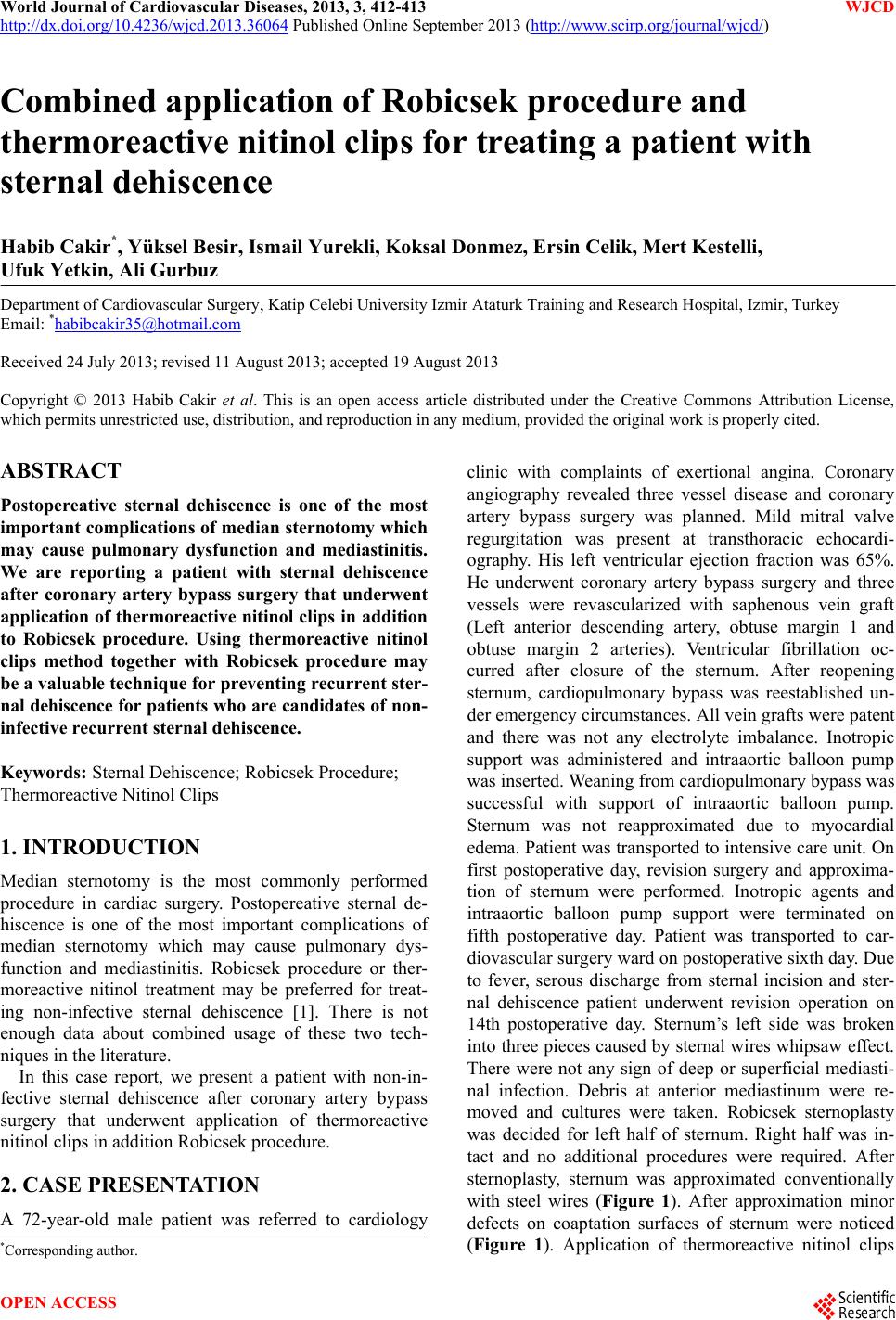
World Journal of Cardiovascular Diseases, 2013, 3, 412-413 WJCD
http://dx.doi.org/10.4236/wjcd.2013.36064 Published Online September 2013 (http://www.scirp.org/journal/wjcd/)
Combined application of Robicsek procedure and
thermoreactive nitinol clips for treating a patient with
sternal dehiscence
Habib Cakir*, Yüksel Besir, Ismail Yurekli, Koksal Donmez, Ersin Celik, Mert Kestelli,
Ufuk Yetkin, Ali Gurbuz
Department of Cardiovascular Surgery, Katip Celebi University Izmir Ataturk Training and Research Hospital, Izmir, Turkey
Email: *habibcakir35@hotmail.com
Received 24 July 2013; revised 11 August 2013; accepted 19 August 2013
Copyright © 2013 Habib Cakir et al. This is an open access article distributed under the Creative Commons Attribution License,
which permits unrestricted use, distribution, and reproduction in any medium, provided the original work is properly cited.
ABSTRACT
Postopereative sternal dehiscence is one of the most
important complications of median sternotomy which
may cause pulmonary dysfunction and mediastinitis.
We are reporting a patient with sternal dehiscence
after coronary artery bypass surgery that underwent
application of thermoreactive nitinol clips in addition
to Robicsek procedure. Using thermoreactive nitinol
clips method together with Robicsek procedure may
be a valuable technique for preventing recurrent ster-
nal dehiscence for patients who are candidates of no n-
infective recurrent sternal dehiscence.
Keywords: Sternal Dehiscence; Robicsek Procedure;
Thermoreactive Nitinol Clips
1. INTRODUCTION
Median sternotomy is the most commonly performed
procedure in cardiac surgery. Postopereative sternal de-
hiscence is one of the most important complications of
median sternotomy which may cause pulmonary dys-
function and mediastinitis. Robicsek procedure or ther-
moreactive nitinol treatment may be preferred for treat-
ing non-infective sternal dehiscence [1]. There is not
enough data about combined usage of these two tech-
niques in the literature.
In this case report, we present a patient with non-in-
fective sternal dehiscence after coronary artery bypass
surgery that underwent application of thermoreactive
nitinol clips in addition Robicsek procedure.
2. CASE PRESENTATION
A 72-year-old male patient was referred to cardiology
clinic with complaints of exertional angina. Coronary
angiography revealed three vessel disease and coronary
artery bypass surgery was planned. Mild mitral valve
regurgitation was present at transthoracic echocardi-
ography. His left ventricular ejection fraction was 65%.
He underwent coronary artery bypass surgery and three
vessels were revascularized with saphenous vein graft
(Left anterior descending artery, obtuse margin 1 and
obtuse margin 2 arteries). Ventricular fibrillation oc-
curred after closure of the sternum. After reopening
sternum, cardiopulmonary bypass was reestablished un-
der emergency circumstances. All vein grafts were patent
and there was not any electrolyte imbalance. Inotropic
support was administered and intraaortic balloon pump
was inserted. Weaning from cardiopulmonary bypass was
successful with support of intraaortic balloon pump.
Sternum was not reapproximated due to myocardial
edema. Patient was transported to intensive care unit. On
first postoperative day, revision surgery and approxima-
tion of sternum were performed. Inotropic agents and
intraaortic balloon pump support were terminated on
fifth postoperative day. Patient was transported to car-
diovascular surgery ward on postoperativ e sixth day. Due
to fever, serous discharge from sternal incision and ster-
nal dehiscence patient underwent revision operation on
14th postoperative day. Sternum’s left side was broken
into three pieces caused by sternal wires whipsaw effect.
There were not any sign of deep or superficial mediasti-
nal infection. Debris at anterior mediastinum were re-
moved and cultures were taken. Robicsek sternoplasty
was decided for left half of sternum. Right half was in-
tact and no additional procedures were required. After
sternoplasty, sternum was approximated conventionally
with steel wires (Figure 1). After approximation minor
defects on coaptation surfaces of sternum were noticed
(Figure 1). Application of thermoreactive nitinol clips
*Corresponding a uthor.
OPEN ACCESS